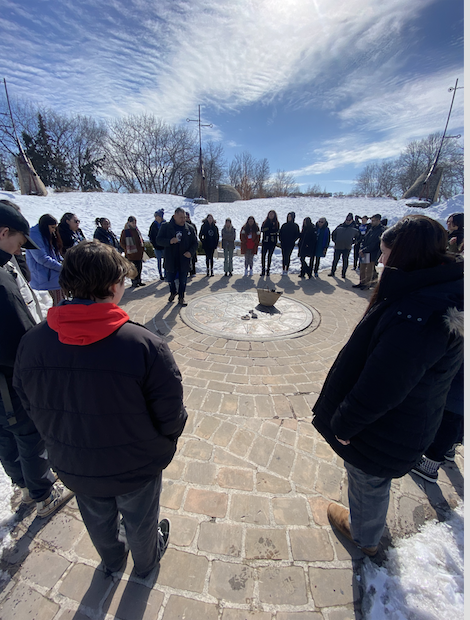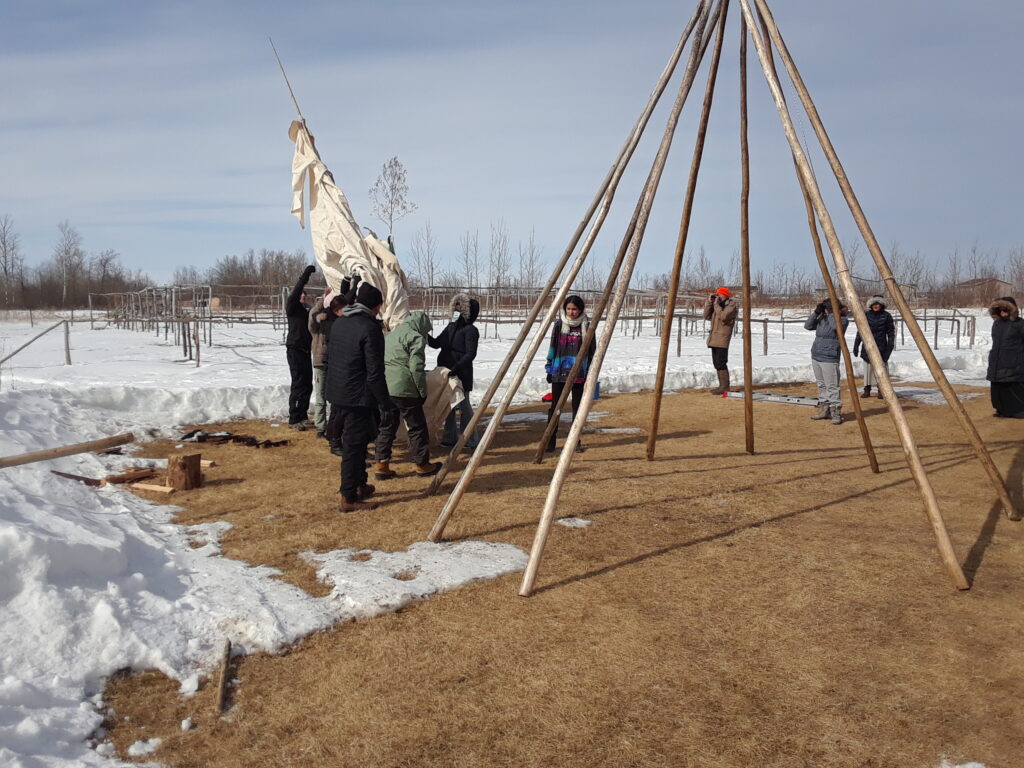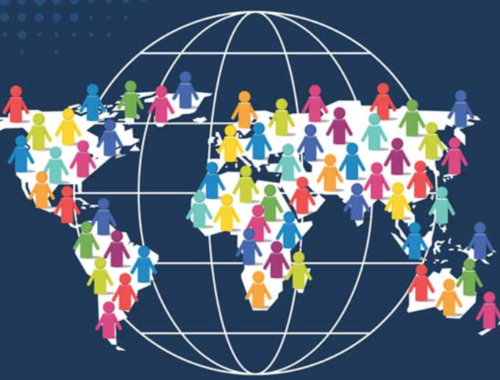Indigenous and Non-Indigenous Youth on the Land Learning and Working Together

There is More Good News in the World Than Bad
Emily* was feeling skittish. In front of her were six large white dead snowshoe hares, waiting to be skinned. She was to be one of the skinners.
She did not want to do this. In fact, it made her feel sick. While optional, she knew it was important for her to participate.

Emily was at a gathering at Turtle Lodge, an Indigenous healing, spiritual and educational facility on the Sagkeeng First Nation Reserve, 200 km north of Winnipeg. Turtle Lodge focuses on land-based education. She was there with 25 Indigenous (First Nation, Métis and Inuit) 15-18-year old’s, and a like number of non-Indigenous young people from across Canada. The gathering was overseen by 30 Indigenous elders and non-Indigenous chaperones from across Canada.
Rabbit skinning was part of the learning about Indigenous culture.
The facilitator of the event was HIP, a partnership of Rotarians and Indigenous Peoples. Their cross-Canada board is 50% Rotarians and 50% Indigenous Peoples. Fifty percent of the board members are women.
HIP stands for Honoring Indigenous Peoples and their focus is education, awareness and building of relationships. https://honouringindigenouspeoples.com/
Emily, who was not Indigenous, was one of 15 young people in the room. Only one of the Indigenous youths in the room had previously skinned a rabbit.
The elder demonstrated the procedure, but before they did the actual skinning, he explained the Indigenous approach and view of nature and the land. The Indigenous Peoples believe that the land and planet have a heartbeat and provide food, shelter, spiritual sustenance and other life necessities such as clothes and tools for people.
In turn, the Indigenous peoples reciprocate by looking after the land, the waters, and the wildlife.
Planet earth is the mother.

He described the inter-connectedness of everything: the waters, the moon, the stars, the rain, the wind, the plants and all species. Furthermore, he said it is important for all species to live together in harmony, not just as one. He stressed how important it is to care for the land and waters. WE must not exploit the land as many non-Indigenous people have done over the years, resulting in the loss of species, such as the Buffalo. Or pollute the waters, such as the many lakes now under water boiling advisories and the mercury contaminated waters at Grassy Narrows. He mentioned the erosion of many lands through overuse and misuse as had happened in the 1930’s and by many, ever since. The elder went on to say we humans are just one species and not superior to other species, that humans do not have DOMINION over the planet or other animals as put forward by some religions. This means it is wise to look at the impact of one’s actions on the whole, not just for the immediate future, but also for the next seven generations (150/175 years) as the Indigenous people do.
Not doing so would deprive our heirs of their rightful inheritance.
While often referring to the Creator, it is not a religion, but a way of life. The good life is not measured in money but in their spiritual connection to the land.
The hares (rabbits) to them were a source of food provided by the creator. By looking after their habitat and only taking what they need the rabbits (hares) would multiply and continue to provide.
The elder then gave a demonstration.
Emily stepped forward, feeling better but still uncertain.

Beside her was a girl called Siren* from a northern reserve. Though she had not done this before, without hesitating, Siren peeled off the fur leaving the innards, meat and bones. This was made into soup. She took the fur home for her mother to use for clothing. Emily did too.
This exercise was just one learning activity the young people did together with many elders and non-Indigenous chaperones.
All of the young people together made small medicine bags, erected a teepee, started a fire with a flint, filleted fish and played a number of Indigenous games.
They were also part of a daily morning ceremony which included drumming. smudging, prayers, and storytelling by both male and female elders.
Stories are how many Indigenous people teach. From these elders they learned about the medicine wheel, the importance of the grandmothers who were often the teachers, guardians of the waters, and providers of safe space. They all learned about the seven sacred teachings wisdom, truth, respect, courage, honesty, humility and love.
They also learned Rotary’s four-way test in all we think and do:
- Is it fair for all concerned?
- Will it build good will and better friendships?
- Will it be beneficial for all?
- Is it the truth?
There was continual talk about care for the land.

The Indigenous peoples learned much too. Many, in spite of their heritage, especially urban dwellers, had not been exposed to the importance of the land.
Said one Indigenous mother on her daughter’s return, “I am glad she learned about the land. Her father and two uncles who would normally teach about the land had all passed.” This was her first time away from home and the mother hoped in a few years’ time her 12-year-old brother could have the same experience.

While embracing Indigenous philosophies about the planet is an important step, some participants were also reminded by a biology professor present of the value of exploring multiple ways of knowing, highlighting Mi’kmaw elder Albert Marshall’s concept of Two-eyed Seeing. This concept connects Indigenous world views and ways with Western thought, science and practice; combining the wisdom of both may not only improve the plight of our planet but also enhance reconciliation. http://www.integrativescience.ca/Principles/TwoEyedSeeing/
The young people connected and mixed beautifully. After hours together of listening they did what teenagers do: hang out together, went to buy food, talked, played on their phones, laughed and just had fun.
These young people, Indigenous and non-Indigenous alike, were fabulously accomplished, and smart. Their ideas of going forward together were insightful.

Some said they are the leaders of tomorrow… many disagreed saying THEY ARE ALREADY THE LEADERS. We must learn from them. At the end it was a huge HUG IN. Everyone was sad to say au revoir, however, the text and emails addresses shared have already resulted in much ongoing interaction.
Till next time,
Chris Snyder
* not their real names
** It should be noted the funding for this gathering came from the Federal Government, Travel Manitoba, Rotary clubs, particularly the Rotary clubs of Selkirk Winnipeg, and Regina Eastview, Hampton Hotel, many individuals, contest winners from the TV program Family Feud, The Museum of Human Rights and the Pegius First Nation.
Countless Rotarians plus Indigenous elders, helpers and chaperones from all across Canada voluntarily gave a week of their time. A great example of everyone working together toward reconciliation and a better world.

Chris Snyder and Bradee McKay
*** Participants also visited the Historic Forks. the Manitoba Museum, and Winnipeg Art Gallery. On the last day everyone gathered at the Museum of Human Rights where all were exposed to the Treaty Commission, the Museum of Human Rights, speakers, and displays of the dark side of history, including the treatment of Indigenous Peoples and other atrocities against humanity, tragedies from which we can all learn. As one elder said, “The dark can be changed by light.”
Mental Health: Some Progress
The Good News of a Smile
You May Also Like

Getting Along and the Golden Rule
July 31, 2022
Saying Positive and Supportive Things to Others
August 13, 2023